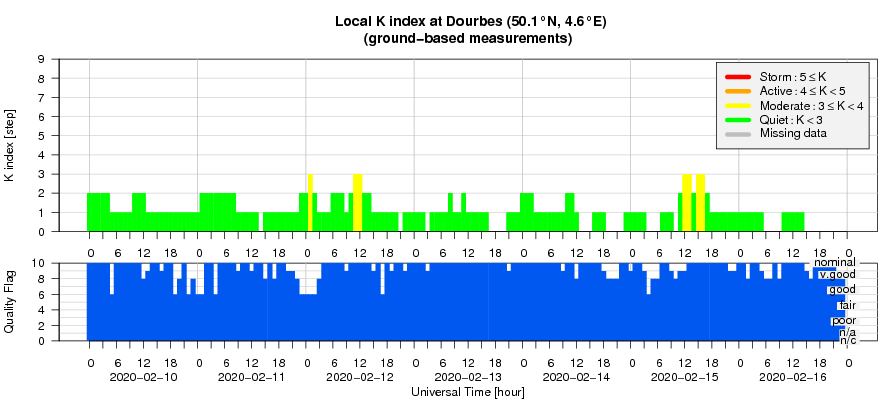- Table of Content
- 1.Review of sola...
- 2.The SIDC space...
- 3.PROBA2 Observa...
- 4.Geomagnetic Ob...
- 5.The Internatio...
- 6.Review of iono...
2. The SIDC space weather Briefing
3. PROBA2 Observations (10 Feb 2020 - 16 Feb 2020)
4. Geomagnetic Observations at Dourbes (10 Feb 2020 - 16 Feb 2020)
5. The International Sunspot Number by SILSO
6. Review of ionospheric activity (10 Feb 2020 - 16 Feb 2020)
Review of solar and geomagnetic activity
Solar activity
The solar activity was very quiet over the past week. The visible solar disc was spotless and the X-ray flux remained below B-level.
No earth-directed coronal mass ejections (CMEs) have been observed in the available coronagraphic imagery. The greater than 10 MeV proton flux was at nominal values.
Geomagnetic activity
The Earth was under the slow solar wind regime with the wind speed ranging between 300 km/s and 450 km/s. The solar wind parameters were slightly enhanced due to wind streams from several small coronal holes (with negative and positive polarity). The interplanetary magnetic field remained below 6.5 nT, and the southward magnetic component fluctuated between -6 nT and 5 nT.
The geomagnetic conditions were mostly quiet, with few isolated periods of unsettled conditions.
The SIDC space weather Briefing
The Space Weather Briefing presented by the forecaster on duty from Feb 9 to 16. It reflects in images and graphs what is written in the Solar and Geomagnetic Activity report.
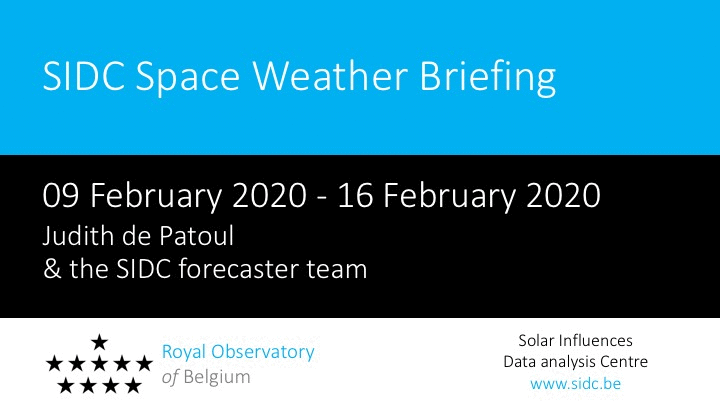
The pdf-version: http://www.stce.be/briefings/20200217_SWbriefing.pdf
The automatically running presentation: http://www.stce.be/briefings/20200217_SWbriefing.ppsm
PROBA2 Observations (10 Feb 2020 - 16 Feb 2020)
Solar Activity
Solar flare activity was very low during the week.
In order to view the activity of this week in more detail, we suggest to go to the following website from which all the daily (normal and difference) movies can be accessed: https://proba2.oma.be/ssa
This page also lists the recorded flaring events.
A weekly overview movie can be found here (SWAP week 516): https://proba2.sidc.be/swap/data/mpg/movies/weekly_movies/weekly_movie_2020_02_10.mp4
Details about some of this week's events can be found further below.
If any of the linked movies are unavailable they can be found in the P2SC movie repository here: https://proba2.oma.be/swap/data/mpg/movies/
Tuesday Feb 11
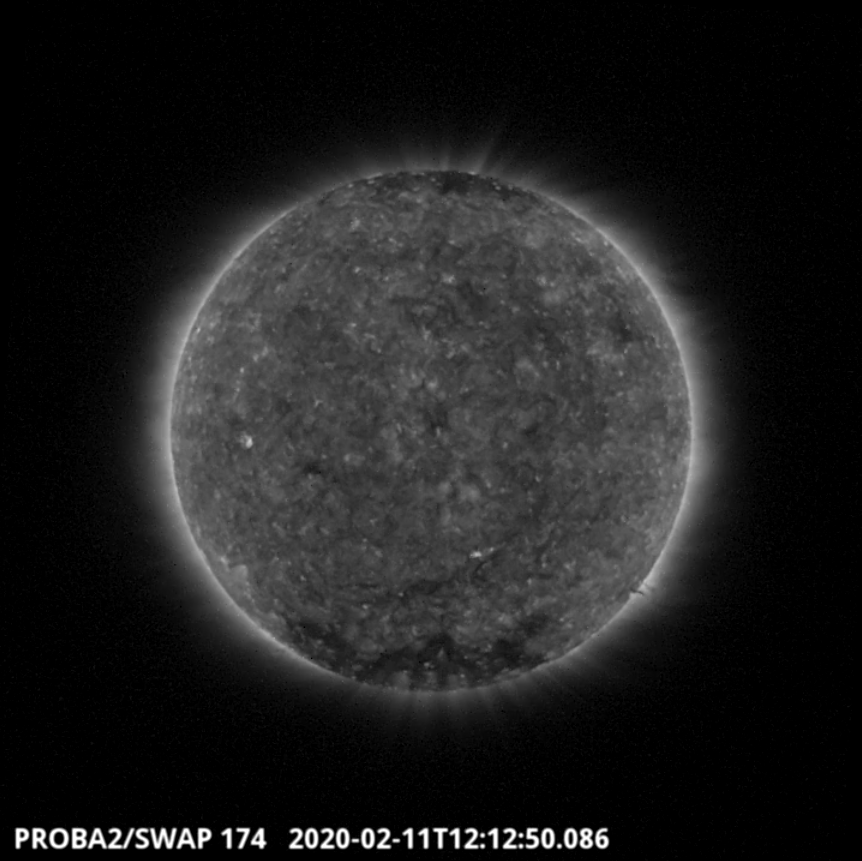
A prominence was observed by SWAP on the south-west limb as shown in the SWAP image above at 12:12 UT.
Find a movie of the event here (SWAP movie): https://proba2.sidc.be/swap/movies/20200211_swap_movie.mp4
The International Sunspot Number by SILSO
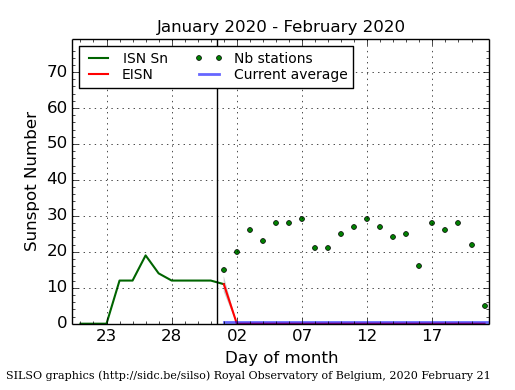
The daily Estimated International Sunspot Number (EISN, red curve with shaded error) derived by a simplified method from real-time data from the worldwide SILSO network. It extends the official Sunspot Number from the full processing of the preceding month (green line). The plot shows the last 30 days (about one solar rotation). The horizontal blue line shows the current monthly average, while the green dots give the number of stations included in the calculation of the EISN for each day.
Review of ionospheric activity (10 Feb 2020 - 16 Feb 2020)
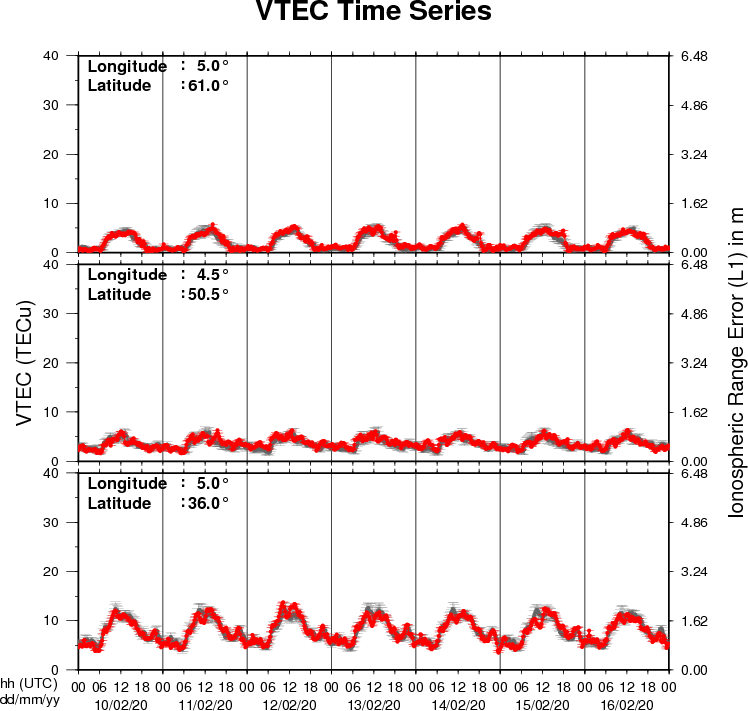
The figure shows the time evolution of the Vertical Total Electron Content (VTEC) (in red) during the last week at three locations:
a) in the northern part of Europe(N61°, 5°E)
b) above Brussels(N50.5°, 4.5°E)
c) in the southern part of Europe(N36°, 5°E)
This figure also shows (in grey) the normal ionospheric behaviour expected based on the median VTEC from the 15 previous days.
The VTEC is expressed in TECu (with TECu=10^16 electrons per square meter) and is directly related to the signal propagation delay due to the ionosphere (in figure: delay on GPS L1 frequency).
The Sun's radiation ionizes the Earth's upper atmosphere, the ionosphere, located from about 60km to 1000km above the Earth's surface.The ionization process in the ionosphere produces ions and free electrons. These electrons perturb the propagation of the GNSS (Global Navigation Satellite System) signals by inducing a so-called ionospheric delay.
See http://stce.be/newsletter/GNSS_final.pdf for some more explanations ; for detailed information, see http://gnss.be/ionosphere_tutorial.php
